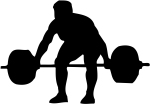- FreeTrainers.com Forums
- Strength & Powerlifting
- Musing... bands vs weight for recovery
Group: Strength & Powerlifting
Created: 2012/01/01,
Members: 38,
Messages: 16459
Discuss the topic of Power lifting, Strength training and Strong Man training!
Join group
Musing... bands vs weight for recovery

Tinnuk
Posts:
291
Joined: 2005/12/19  |
2008/02/24, 08:12 PM
Please, ramble away; this is perhaps the most interesting thing I've looked at all day. I'll admit I'm a tad confused in regard to what you mean about a "natural pumping action" being an advantage...or actually, maybe I'm not? Are you referring to the brief increases in pressure as a result of the breif blood restriction from the contraction? Sort of like pinching a hose and letting go?
Not to stray too far from the subject, but is recovery work such as this to be done on off days, or simply later in the day after a workout? |
|
| |

Tinnuk
Posts:
291
Joined: 2005/12/19  |
2008/02/24, 11:15 PM
============ Quoting from wrestler125: To get a bit more exact. the vasodilation and vasoconstriction caused by contraction and relaxation will be there regardless of the amount of weight lifted. In other words, you can do very little work, and consequently very little damage to the muscles, and still get a good deal of blood flow. ============= Why not just go for a walk or something then? |

wrestler125
Posts:
4,619
Joined: 2004/01/27  |
2008/02/24, 05:30 PM
I think Louie Simmons is wrong.
There, I said it. And I didn't even get struck by lightning when I benched today... In multiple articles, Dave Tate has said that Louie often has his guys (dave included) do high rep band work, for example, sets of 100 for pushdowns, in order to promote blood flow and aid in recovery. I thought this was a great idea until I learned the difference between static and dynamic work. In biomechanics, a static task is any task that is somewhat isotonic in nature, ie the muscles are in a constant and relatively level state of tension. A dynamic task is one that involves more movement. Think holding a tray vs picking it up and setting it down. Bands work differently then freeweight, in that the acceleration is MUCH greater than gravity. This puts the muscles in a constant state of tension. Anyone that has done band work will know what I mean. Even at the top and on the way down, there is no relaxing. When we calculate maximum physical work capacity we do it differently for static tasks vs dynamic tasks. The reason for this is simple... static tasks reduce blood flow. Since the muscle is under constant tension, it restricts blood flow for the duration of the set. At the end of the set, a pump may set in after the hypoxia. This is different than using freeweights, which would naturally cause a pumping movement with every repetion, but no significant hypoxia. I'm not saying this is a terrible thing. As far as muscle growth is concerned, this is great, since hypoxic states have been shown to lead to greater hypertrophy (this principle leads to many BB principles). However, for recovery, I think this might be less than optimal. Maybe, just maybe, we should be doing them with freeweights. Surprisingly, this is one of the principles of the reverse hyper. Not only is it supposed to rotate and distract the sacrum to allow fluid to flow between the disks, but it also combines stretching and contraction to promote blood flow to the erectors. Any thoughts? I'm probably overthinking things like this (I doubt any of this will significantly affect anyones training), but when you spend as much time as I do in a lab analyzing work tasks, you tend to miss the gym. -------------- SQUAT MORE ~Jesse Marunde Blood Guts Sweat Chalk |

Tinnuk
Posts:
291
Joined: 2005/12/19  |
2008/02/24, 06:09 PM
Perhaps the body would overcompensate after being in a hypoxic state, by increasing the blood flow to the area that was perfoming the static task for a long time afterwards; the total increase in blood flow could be greater than what a dynamic task would stimulate.
|

wrestler125
Posts:
4,619
Joined: 2004/01/27  |
2008/02/24, 07:32 PM
That was one of my thoughts as well. However, since the NIOSH equation for maximum physical work capacity takes into account rest periods, I would believe this to not be the case.
Also, since a dynamic task involves a natural pumping action, it is not only clearing away the metabolic waste from the task, but also from prior use. The actual task would not have to be difficult in nature or in level of intensiveness, whereas to get a pump from a static task would require the intensiveness to be higher and a certain amount of damage to be done before blood flow would be increased at all. Did that make sense? It did in my head. I can explain further, but don't want to ramble. -------------- SQUAT MORE ~Jesse Marunde Blood Guts Sweat Chalk |

gatormade
Posts:
1,355
Joined: 2003/10/01  |
2008/02/24, 09:42 PM
The goal of any recovery work is to feel better faster so you can train harder in the next workout. Bands have always worked for me. You also have to make sure your band tension is the correct tension for recovery work.
|

wrestler125
Posts:
4,619
Joined: 2004/01/27  |
2008/02/24, 09:53 PM
You're close. Contraction and relaxation cause vasodilation and vasoconstriction.
I've generally done my recovery work on off days. Usually the day after. I do the bulk of my rehab stuff the day after I squat. It gets blood into my legs and gets most of the rehab stuff out of the way. -------------- SQUAT MORE ~Jesse Marunde Blood Guts Sweat Chalk |

wrestler125
Posts:
4,619
Joined: 2004/01/27  |
2008/02/24, 09:56 PM
To get a bit more exact. the vasodilation and vasoconstriction caused by contraction and relaxation will be there regardless of the amount of weight lifted. In other words, you can do very little work, and consequently very little damage to the muscles, and still get a good deal of blood flow.
However, since band work is more static... any pump achieved from it is a result of the hypoxia and damage to the muscle. Of course, if anyone was ACTUALLY concened with how this affected their training, the bands could be set up so there wasn't tension at all at the top portion, and then briefly stop at the top of each rep. -------------- SQUAT MORE ~Jesse Marunde Blood Guts Sweat Chalk |

wrestler125
Posts:
4,619
Joined: 2004/01/27  |
2008/02/24, 11:27 PM
Going for a walk won't get blood into your triceps. Also, I do some light high bar squatting the day after my legs workout not only to help with recovery, but to help stretch out my hips. Also, it gets me warm for the rehab stuff.
Walking is great for recovery. I do it for many miles a day, though most of that is to class and work. I know of quite a few strongman competitors who feel that regular long walks are the best thing for recovering from many kinds of back overuse. -------------- SQUAT MORE ~Jesse Marunde Blood Guts Sweat Chalk |

rev8ball
Posts:
3,081
Joined: 2001/12/27  |
2008/02/25, 03:07 AM
This reminds me of lit review summary of Exercise Hyperemia that I wrote not too long ago. Below is an abbreviated version; kind of interesting in context of this thread:
Exercise Hyperemia Several factors may occur when discussing blood flow to and within a muscle. The only problem is that there is no consensus on exactly how and when they transpire. First, there is a definite physical and mechanical characteristic that occurs, and seems to have its biggest impact in the first few seconds of muscle contraction. As the muscle contracts, it may actually ?kink? or ?clamp off? blood vessels leading to and within the tissue. With fluid mechanics in physics, a decrease in volume (fluid vessel) is an increase in pressure. Therefore, when one gets kinked, the pressure of blood delivery increases. This is also related to muscle contraction frequency, and motor unit recruitment. There are also definite chemical and biological variables, especially when dealing with the type of fuel system (metabolic demands) of a particular exercise; these seem to act slower than the mechanical causes, though, and may act in partial unison to increase their time and ability of increasing the transportation of blood during exercise. Within the first few seconds of a movement, especially an explosive lift, it requires only ATP-PC as fuel, and the increase in blood is relatively small, but due mostly to mechanical occurrences. However, as fast glycolysis comes in to play (<30 seconds), the delivery of fuel to the muscle and the removal of waste from the muscle increases in importance, and the effects of chemical/biological vasodilators begin to take place. As the body goes through slow glycolysis and transfers to oxidative, it settles into a steady state of fuel delivery and use, as well as more of a rhythm, and the increase of blood flow decreases, and finally levels off. This appears to be the reason why individuals employing resistance training will feel more of a muscle ?pump? in the greater than 10 and less than 30 second range, or, more notably, roughly the 8-12 rep range, also know as the hypertrophy range. When training for strength and power, explosive movements are kept at <6 reps, and are completed within a few seconds. Blood flow is increased, but not to the level of the previous example. This is also true, but on the other side of the spectrum, for training aerobically, such as a marathon; as the body gets into a rhythm, blood flow decreases until it reaches a steady state. -------------- Michael Strength & Conditioning is not everything; it just really sucks to be weak and slow. |

Tinnuk
Posts:
291
Joined: 2005/12/19  |
2008/02/25, 03:53 PM
I'm assuming that the rep range for the "pump" that this goes on about is also taking into account the resistance, which I doubt would be used for recovery work; this is interesting none the less.
It seems that the principle behind this is creating metabolic waste to increase blood flow, but wouldn't the recovery work simply be creating a reason for the blood to be there; does the increase in blood flow overcompensate and clear away old metabolic waste as well? Does a spike in pressure actually help in the clearing of metabolic waste? |

Tinnuk
Posts:
291
Joined: 2005/12/19  |
2008/02/25, 03:53 PM
I'm assuming that the rep range for the "pump" that this goes on about is also taking into account the resistance, which I doubt would be used for recovery work; this is interesting none the less.
It seems that the principle behind this is creating metabolic waste to increase blood flow, but wouldn't the recovery work simply be creating a reason for the blood to be there; does the increase in blood flow overcompensate and clear away old metabolic waste as well? Does a spike in pressure actually help in the clearing of metabolic waste? |

Tinnuk
Posts:
291
Joined: 2005/12/19  |
2008/02/25, 03:58 PM
Sorry bout' that; I don't know why that double posted...
|

coolnatedawg
Posts:
813
Joined: 2005/03/09  |
2008/02/25, 04:31 PM
can you all put this into idiot terms. i seem to glaze over when it gets to technical.
|
